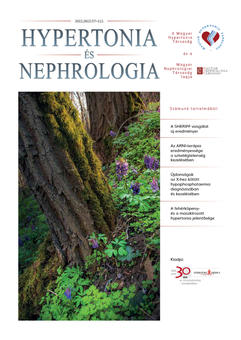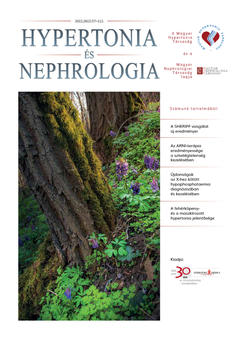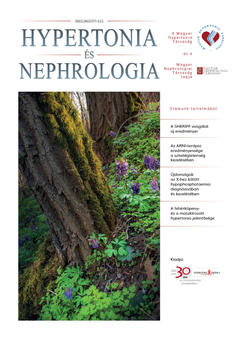The eLitMed.hu medical portal uses computer cookies for convenient operation. Detailed information can be found in the Cookie-policy.
Hypertension and nephrology - 2022;26(02)
Content
[Cilostazol improves quality of life and lower limb functional capacity in lower extremity arterial disease regardless of age and gender – new results of the SHort-tERm cIlostazol eFFicacy and quality of life (SHERIFF) study]
[Intermittent claudication has a significant negative impact on the patients’ quality of life. Revascularization procedures and noninvasive medical therapie scan improve walking capacity. Cilostazol has IA recommendation for the treatment of intermittent claudication (IC). The aim of this study was to evaluate the effect of three-month cilostazol treatment on the health related quality of life and on the lower limb functional capacity in women (F) and men (M), in patients under 65 years of age (Y) and among patients 65 years of age or older (O) with intermittent claudication in the clinical practice. The study was a multicenter, non-interventional trial, 812 lower extremity arterial disease (LEAD) patients (Fontaine II stage, mean age: 67.17 years, male/female: 58.25/41.75%, 506 patients aged ≥65 years) were enrolled, who received cilostazol (50 or 100 mg b.i.d.) for three months. Quality of life was evaluated with the EQ- 5D-3L questionnaire, functional capacity with the WELCH questionnaire. Walking distances, ankle-brachial index were measured at baseline and after 3-month. Upon conclusion of the study, the EQ-5D index improved (baseline: F [female] –0.49±0.23, M (male –0.44±0.22, Y (age <65 years) –0.45±0.21, O (age ≥65 years) –0.47±0.23; 3rd month: –0.27±0.18, –0.25±0.18, –0.25±0.18, –0.26±0.18; respectively, p<0.0001) and there was a significant increase in the WELCH score as well (baseline: F 18±13, M 20±14, Y 21±14, O 18±13; 3rd month: 31±18, 32±18, 32±19, 31±17; respectively, p<0.0001). Both pain-free and maximal walking distance increased: F 60.94%, (median: +50.26%), 49.57%, (median: + 42.86%), M 50.22%, (median: +50%), 37.7%, (median: + 33,33 %), Y 54,35 %, (median: + 56,2%), 36.78%, (median: +42.86%), O 54.62%, (median: +50%), 46.29% (median: +33.33%); respectively (p<0.001). Three months of cilostazol treatment improved quality of life and lower limb functional capacity in claudicant patients regardless of age and gender. The WELCH questionnaire is a useful tool in clinical practice for the evaluation of intermittent claudication treatment.]
[The efficiency of angiotensin receptor blocker/neprilysin inhibitor (ARNI) treatment in heart failure 2021 ARNI, VIDI, VICI…]
[A new compound ARNi (valsartan/sacubitril) – as a member of a new pharmacoterapeutic group – has several clinical evidences almost in the whole spectrum of heart failure, especially in case of reduced left ventricular ejection fraction and hypertension. The most important and essential evidence based studies and the efficiency of the treatment with ARNI in heart failure have been demonstrated in this overview. Due to the favorable results of the studies the recommendations of ARNI indication are increasingly dominant in the clinical guidelines. The usage provides effective, safe therapeutic help for the poor life expectancy heart failure patients in the everyday clinical practice. The treatment is already available in Hungary.]
[Novelties in the diagnosis and treatment of X-linked hypophosphatemia]
[X-linked hypophosphataemia (XLH) is the most common inherited cause of phosphate wasting. Its pathogenesis is complex, determined by the dysregulation of phosphate homeostasis and bone metabolism. We review herein the pathophysiology of XLH leading to multiple manifestations, stages of diagnosis and the treatment strategies. XLH is now in the scientific interest of pediatric nephrology, because a new treatment modality, burosumab became available in Hungary. Burosumab is a monoclonal antibody against fibroblast growth factor 23 (FGF-23). XLH is caused by the loss of function mutations in ”phosphate regulating endopeptidase homolog, X-linked” (PHEX) gene, which results enhanced secretion of the phosphaturic hormone FGF-23. The diagnosis of XLH is based on signs of rickets and/or osteomalacia and decreased growth velocity in association with hypophosphataemia and renal phosphate wasting in the absence of vitamin D or calcium deficiency. Conventional treatment with oral phosphate supplementation together with active vitamin D (calcitriol or alfadiol) can improve bone metabolism, but only partial results can be achieved, and can promote side effects (nephrocalcinosis). The better understanding of the role of PHEX gene and FGF-23 levels in the pathomechanism helped to identify therapeutic options more properly. With monoclonal antibody therapy against FGF-23 the disease process can be interrupted, and complications can be prevented if the therapy is initiated in time. However, deformities already leading to disability cannot regress completely during burosumab therapy, highlighting the need of early diagnosis and the start of the biological treatment before complications.]
[The importance of white-coat and masked hypertension: novelties]
[White-coat hypertension is a heterogenous clinical entity includes patients with lower and higher cardiovascular risk. It has a relative benign prognosis if it is not associated with other cardiovascular risk factors. It can increase, however, significantly the risk of new onset sustained hypertension and diabetes. The risk of cardiovascular events is unequivocally higher than that of normotensive patients, according to recent studies. Therefore, the proper evaluation of cardiovascular risk has utmost importance in white-coat hypertensive patients to determine the adequate treatment and follow-up. Masked hypertension, in the other hand, is not a benign phenotype, therefore regular screening with out-of office blood pressure measurements and pharmacological blood pressure lowering therapy is mandatory.]
[Chronic stress in the development of essential hypertension. Role of rilmenidine in the treatment of stress induced hypertension]
[Hypertension is an independent risk factor of cardiovascular diseases. Several factors contribute to its development, including chronic stress, which may induce hypertension by increasing sympathetic activity. The signs of increasing sympathetic activity can be primarily detected in the initial phase of hypertension, which is characterized by the increase in cardiac output. In addition to the hemodynamic consequences (increase in cardiac output, tachycardia, coronary vasoconstriction, proarrhythmia), the increase in sympathetic activity has many harmful effects. Numerous metabolic (insulin resistance, dyslipidemia), structural and trophic effects (endothelial dysfunction, vascular hypertrophy, myocardial hypertrophy), as well as thrombotic and humoral processes (procoagulation, enhancement of thrombocyte aggregation, sodium retention, activation of the renin-angiotensin-aldosterone axis) may develop and consequently damage body functions at many targets. Several different antihypertensive drug classes are available for reducing increased sympathetic activity, including peripheral alpha and beta blockers and centrally acting drugs. First generation antihypertensive drugs with central mechanisms of action (e.g. clonidine, guanfacine, alpha-methyldopa) is currently rarely administered and only for a few indications as they have a significant adverse events profile. Among centrally acting, second generation drugs, rilmenidine stimulates imidazoline-I1 receptors and thus beneficially influences mild or moderate hypertension that involves enhanced sympathetic nervous system activity.]
[Echocardiographic judgment of the left ventricular remodelling and heart failure’s types]
[The heart responds to the damage to the heart muscle with various changes that are regulated by complex processes. If the harm is irreversible, changes that begin as an adaptation can become chronic and permanently worsen heart function. The author details below the pathological remodelling of the left ventricle that can lead to heart failure. It covers the types of heart failure based on the latest recommendations and presents the echocardiographic examination methods that can be used to assess the diastolic, systolic and right ventricular function of the heart.]
1.
Clinical Neuroscience
Is there any difference in mortality rates of atrial fibrillation detected before or after ischemic stroke?2.
Clinical Neuroscience
Factors influencing the level of stigma in Parkinson’s disease in western Turkey3.
Clinical Neuroscience
Neuropathic pain and mood disorders in earthquake survivors with peripheral nerve injuries4.
Journal of Nursing Theory and Practice
[Correlations of Sarcopenia, Frailty, Falls and Social Isolation – A Literature Review in the Light of Swedish Statistics]5.
Clinical Neuroscience
[Comparison of pain intensity measurements among patients with low-back pain]1.
Clinical Neuroscience Proceedings
[A Magyar Stroke Társaság XVIII. Kongresszusa és a Magyar Neuroszonológiai Társaság XV. Konferenciája. Absztraktfüzet]2.
3.
Journal of Nursing Theory and Practice
[A selection of the entries submitted to the literary contest "Honorable mission: the joys and challenges of our profession" ]4.
Journal of Nursing Theory and Practice
[End of Life and Palliative Care of Newborns in the Nursing Context]5.
Journal of Nursing Theory and Practice
[Aspects of Occupational Health Nursing for Incurable Patients ]







